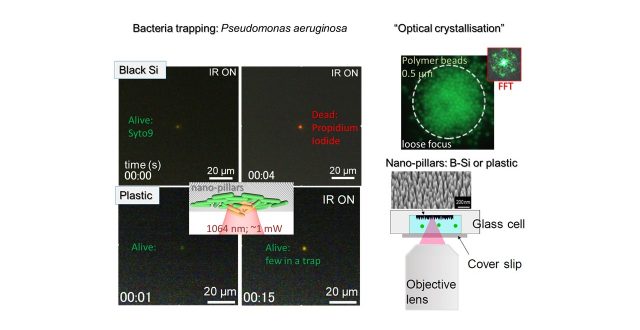The optical trapping of polymer beads of different diameters d of 100, 200, 500, 1000, and 3000 nm on planar (F-Si) and nanostructured (BSi) crystalline silicon was investigated at laser wavelengths λ = 808 and 1064 nm, respectively. We demonstrate that BSi surfaces can enhance the optical gradient force required to grip nanoparticles (100 nm) in contrast to F-Si surfaces, significantly changing the trapping behavior. Thus, different modes of optical tweezing were characterized by modification of Si surface topography (nanostructuring), wavelength λ, laser irradiation intensity I, and irradiation area. Specifically, we present four separate modes of optical tweezing using planar and nanostructured Si for (i) a single particle trapped by tightly and loosely focused irradiation on F-Si, (ii) a large number of 3D assembled beads trapped by tightly focused irradiation on BSi, (iii) a small number of particles trapped on F-Si, and (iv) a large number of particles trapped on BSi, resulting in a 2D self-ordered assembly. The mechanisms of the optical manipulation of particles in the range 100–1000 nm were discussed with implications for the trapping of bacteria or viruses by using nanostructured semiconductor assisted optical tweezing (NASSCA/OT) and their response to high mechanical shear forces at locally changed temperatures on nanostructured surfaces.

Optical trapping/binding of bacteria (or virus) on nano-sharp surfaces is introduced for mechanical and thermal testing of bio-membranes
WRHIからのお知らせ おすすめ
物質理工学院 Saulius Juodkazis特任教授の国際共著論文
“Optical Trapping of Polystyrene Nanoparticles on Black Silicon: Implications for Trapping and Studying Bacteria and Viruses”
が、 ACS Appl. Nano Mater. にオンライン掲載されました。(DOI:10.1021/acsanm.0c01901 )
詳しくはこちら
<Abstract>
